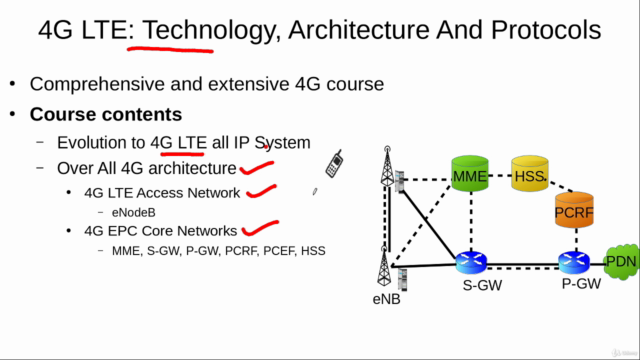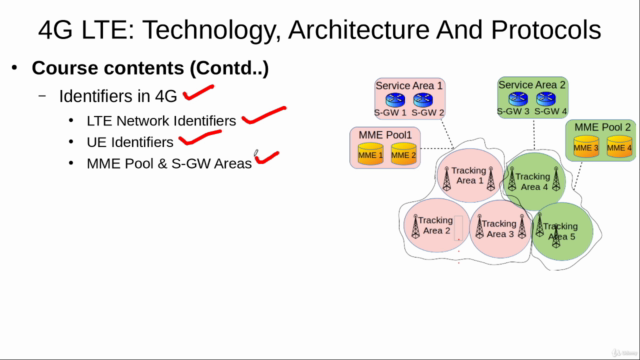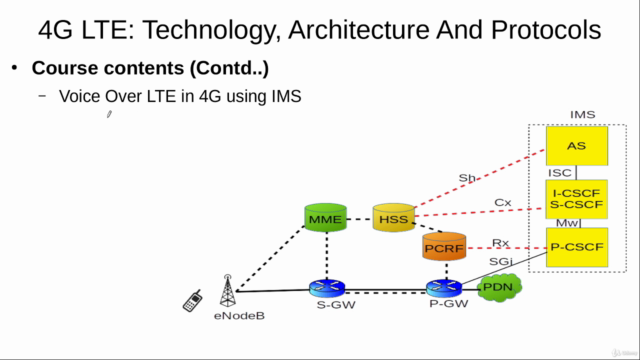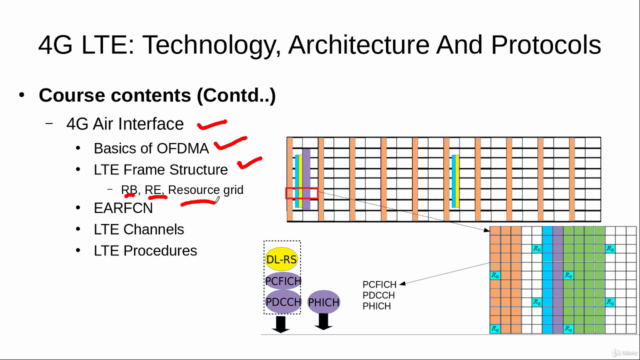4G LTE: Technology, Architecture, Protocols & KPIs

Why take this course?
4G LTE (Long-Term Evolution) is a pioneering technology standardized by the 3rd Generation Partnership Project (3GPP) as Evolved Packet System (EPS). The LTE air interface is a critical component of the EPS architecture and plays a vital role in the overall functionality and performance of the system. Here's an overview of the key aspects of the 4G LTE air interface:
Layer Overview
- Physical Layer (L1): It defines the transmission scheme, modulation/demodulation techniques, and the multiple access scheme. LTE uses OFDMA in the downlink (BS to UE) and SC-FDMA in the uplink (UE to BS).
- Data Link Layer (L2): This layer is responsible for data transfer between UEs and the Evolved Node B (eNB). It includes functions such as Hybrid Automatic Repeat reQuest (HARQ), Adaptive Modulation and Coding (AMC), and Packet Data Convergence Protocol (PDCP).
- Network Layer (L3): This layer provides radio resource management, including scheduling, admission control, mobility management, and measurement reporting.
- Transport Layer (L4-5): It provides a transport mechanism for data across the air interface, including the Radio Resource Control (RRC) protocol.
Key Features
- Carrier Aggregation: Combines multiple contiguous frequency bands to increase the bandwidth and improve data rates.
- MIMO (Multiple Input Multiple Output): Uses multiple antennas at both the UE and eNB to transmit and receive data simultaneously, increasing capacity and speed.
- Scalable Bandwidth: Supports variable channel bandwidths from 1.4 MHz up to 20 MHz and beyond to accommodate different spectrum allocations.
- Flexible Duplexing: FDD (Frequency Division Duplexing) uses separate frequency bands for uplink and downlink, while TDD (Time Division Duplexing) uses the same frequency band for both but in different time slots.
- Advanced Error Correction: Uses HARQ to improve error performance, providing quick retransmission of corrupted packets without waiting for acknowledgements.
- Quality of Service (QoS): Supports class identifiers (CIs) and barring indicators (BIs) to allocate resources according to different service requirements.
LTE Air Interface Operation
- Downlink (eNB to UE): Data packets are transmitted over the downlink shared channel (DL-SCH), which uses OFDMA. The eNB schedules resource blocks for each UE, considering their current QoS requirements and network conditions.
- Uplink (UE to eNB): Data packets from the UE are transmitted using SC-FDMA, which is designed to minimize adjacent channel interference. The UE transmits its data using resources allocated by the eNB.
- Control Signaling: The Radio Resource Control (RRC) protocol is used for setting up and maintaining sessions and handling mobility.
- Evolved Packet Core (EPC): LTE relies on the EPC for routing packets, policy enforcement, and subscriber authentication, among other functions.
Enhancements for 5G
With the advent of 5G, several enhancements over the LTE air interface are being introduced:
- New Frequencies: 5G primarily operates in higher frequency bands (mmWave) that offer wider bandwidths but have more stringent propagation characteristics.
- Massive MIMO: Uses a large number of antennas at the base station to serve multiple users simultaneously, improving capacity and coverage.
- Network Slicing: Enables the creation of logically and physically separate networks over a common shared infrastructure.
- New Radio (NR): The term used for 5G air interface, which includes new modulation schemes like DFTS-BPSK and advanced signal processing techniques.
The LTE air interface is a sophisticated system that has been the foundation for mobile broadband for over a decade. Its successor, NR, will further advance the capabilities of wireless communication systems with even higher data rates, lower latency, and greater flexibility.
Course Gallery




Loading charts...